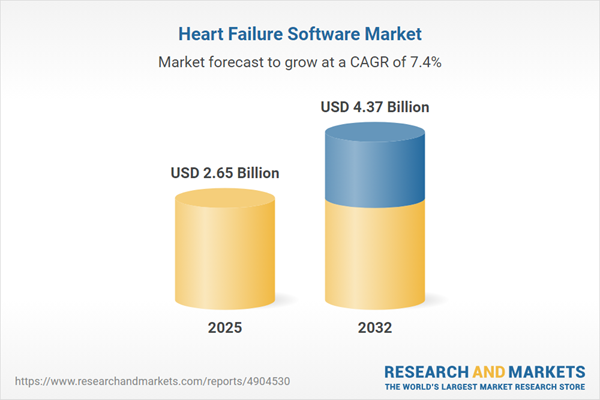Speak directly to the analyst to clarify any post sales queries you may have.
The heart failure software market is entering a pivotal phase as advanced tools redefine patient care, operational efficiency, and strategic decision-making for providers and suppliers across global healthcare ecosystems.
Market Snapshot: Heart Failure Software Market Growth and Outlook
The Heart Failure Software Market expanded from USD 2.47 billion in 2024 to USD 2.65 billion in 2025. With a consistent compound annual growth rate of 7.36%, the sector is projected to reach USD 4.37 billion by 2032. This growth reflects sustained investments in digital heart failure management, the rise of remote care, accelerated adoption of artificial intelligence, and evolving reimbursement frameworks that favor outcomes-driven models.
Scope & Segmentation
This report analyzes the heart failure software market through a comprehensive lens, covering solution types, disease applications, deployment preferences, and end-user segments across diverse global regions.
- Type: Knowledge based systems leveraging clinical guidelines; Non-knowledge based platforms utilizing data-driven analytics.
- Disease Type: Congenital, left-sided, and right-sided heart failure, each requiring tailored workflow solutions and interfaces.
- Platform: Integrated architectures for large enterprises; standalone applications offering modularity and quick launches.
- Application: Clinical decision support, data analytics, EMR integration, patient-centric mobile tools, predictive analytics, and telehealth-enabled remote monitoring.
- End-User: Clinics, homecare settings, and hospitals—each with distinct usability and security priorities.
- Deployment Model: Cloud-based systems for scalability, on-premises for data control, and web-based deployments balancing access and governance.
- Geography: Americas, Europe, Middle East & Africa, Asia-Pacific (including detailed regional and country-level analysis).
- Companies Covered: In-depth trends and strategies are examined for major providers including Abbott Laboratories, Medtronic PLC, Siemens AG, Oracle Corporation, and others.
Key Takeaways for Senior Decision-Makers
- Advanced analytics and clinical expertise are merging to enable personalized heart failure pathways, supporting early intervention and clinician decision-making.
- Interoperability standards and regulatory alignment are reshaping software design, driving unified care records and improved collaboration among care teams and payers.
- Value-based care reimbursement is encouraging real-world validation of platforms and targeted risk-sharing agreements with stakeholders throughout the value chain.
- Market adoption reflects a dual focus: empowering clinicians for acute management and equipping patients for long-term self-care and adherence, both backed by robust data exchange and mobile platforms.
- Integration with EMRs and real-time monitoring devices enhances both acute and chronic care delivery, streamlining workflows and amplifying operational efficiency for large hospital networks and outpatient providers.
- Industry competition is fueled by both global enterprise vendors delivering end-to-end solutions and agile startups specializing in platform-agnostic, rapid-deployment tools validated through real-world studies.
Tariff Impact on Supply Chain and Cost Structure (United States)
Recent U.S. trade policy changes have introduced tariffs affecting hardware components like servers and monitoring devices within the heart failure software supply chain. This has prompted providers to diversify sourcing through localization and new partnerships, while software vendors are shifting to cloud-native, subscription-based platforms to mitigate capital expenditure and hardware dependency. Healthcare organizations now prioritize flexible, shared-risk agreements and performance-based pricing to safeguard care quality amid changing trade dynamics.
Methodology & Data Sources
Insights derive from a blend of in-depth literature reviews, primary interviews with clinical and industry stakeholders, and triangulation of qualitative and quantitative sources. The research applied frameworks such as SWOT, maturity models, and value chain analysis, reinforced by expert reviews and peer validation.
Why This Report Matters
- Anticipate shifting technology, reimbursement, and regulatory trends to support timely, evidence-based strategic investments.
- Leverage competitor benchmarking and best practices tailored to distinct provider types and global healthcare environments.
- Support operational planning with actionable intelligence on adoption patterns, key drivers, and user preferences for scalable software deployment.
Conclusion
Digital heart failure management is rapidly transforming care delivery, blending analytics, interoperability, and patient engagement for measurable gains in clinical and operational outcomes. This research supports agile strategy formation for organizations seeking to lead cardiac care innovation.
Additional Product Information:
- Purchase of this report includes 1 year online access with quarterly updates.
- This report can be updated on request. Please contact our Customer Experience team using the Ask a Question widget on our website.
Table of Contents
3. Executive Summary
4. Market Overview
7. Cumulative Impact of Artificial Intelligence 2025
Companies Mentioned
The companies profiled in this Heart Failure Software market report include:- Abbott Laboratories
- AliveCor, Inc.
- Astellas Pharma Inc.
- Axis Clinical Software, Inc.
- Biofourmis Inc.
- Biome.io
- BIOPAC Systems Inc.
- Boston Scientific Corporation
- Canon Medical Systems Corporation
- Cardiac RMS, LLC by DocGo, Inc.
- CitiusTech Inc.
- Cleerly, Inc.
- CV Medical Software
- Dyad Medical Inc.
- Eko Health Inc.
- Elucid Bioimaging Inc.
- Endotronix, Inc
- Epic Systems Corporation
- Foundry Innovation & Research 1 Ltd.
- GE HealthCare Technologies Inc.
- Heart Input Output Inc.
- Implicity
- International Business Machines Corporation
- iRhythm Technologies, Inc.
- Koninklijke Philips N.V.
- Medtronic PLC
- N. Harris Computer Corporation
- NorthEast Monitoring, Inc.
- Oracle Corporation
- PaceMate, LLC
- Pacertool AS
- Precordior Ltd.
- Siemens AG
- Ultromics Limited
- VectraCor Inc.
- VUNO Inc.
- ZOLL Medical Corporation
Table Information
| Report Attribute | Details |
|---|---|
| No. of Pages | 199 |
| Published | November 2025 |
| Forecast Period | 2025 - 2032 |
| Estimated Market Value ( USD | $ 2.65 Billion |
| Forecasted Market Value ( USD | $ 4.37 Billion |
| Compound Annual Growth Rate | 7.3% |
| Regions Covered | Global |
| No. of Companies Mentioned | 38 |









